


THE FOUNDING OF JAMESTOWN, VIRGINIA 1607 (J1)
Acknowledgements
Aerial View: date
and artist unknown. Bacon’s Rebellion:
engraving entitled The Burning of Jamestown, 1676, from The
Illustrated School History of the United States,
published in 1857, artist unknown. Smith:
18th century coloured engraving after portrait by the Dutch artist
Simon de Passe (1595-
Including:
John Smith,
Pocahontas and
Samuel de Champlain

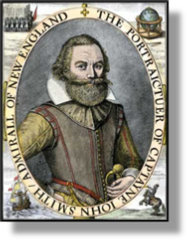 xxxxxA man who played an important part in the early days
of the colony was the English soldier of fortune Captain John Smith (1580-
xxxxxA man who played an important part in the early days
of the colony was the English soldier of fortune Captain John Smith (1580-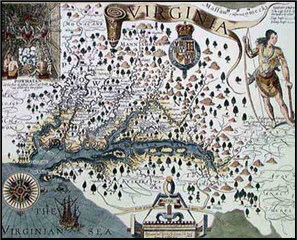 however,
to keep the colony in good order over the bitter winter of 1609-
however,
to keep the colony in good order over the bitter winter of 1609-
xxxxxOn arrival at
Jamestown, Smith began a series of river journeys which enabled
him to produce an amazingly accurate map of Virginia (illustrated). It was while on
one of these exploratory excursions in 1607 that he was captured by
a local Indian tribe and taken to their chief, known to the settlers
as Powhatan. Sentenced to death, he was saved -
xxxxxSmith was
born in Willoughby, Lincolnshire. Eager for a life of adventure,
at the age of 20 he went to fight against the Turks in Hungary. On
his return in 1604, he invested in the Virginia Company -
xxxxxApart from
being an accomplished cartographer, Smith was a prolific and
attractive writer, and his accounts of his travels, particularly
those in North America, did much to stimulate interest in further
colonisation. His writings -
xxxxxThe soldier
of fortune Captain John Smith (1580-
xxxxxAs we have
seen, the colony founded by Sir Walter Raleigh in 1585 (L1)
was found abandoned in 1590. The first permanent English
settlement was established at Jamestown, Virginia in May 1607 by a small band of
adventurers, and managed to survive due to the arrival of some new
settlers three years later. The colony began to prosper with the
production of cotton and tobacco, but two Indian attacks in 1622
and 1664 caused enormous damage, and then, during an internal
revolt in 1676 -
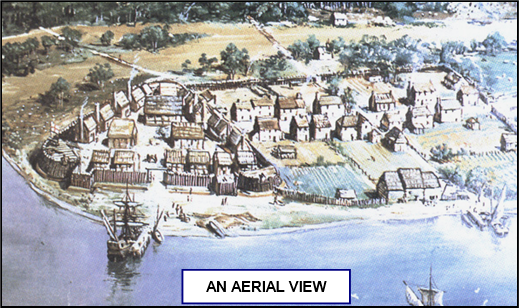 xxxxxAs we have seen, the English adventurer Sir Walter
Raleigh had failed in the 1580s to found a colony on Roanoke
Island, off the coast of Virginia. It was established in 1585 (L1), re-
xxxxxAs we have seen, the English adventurer Sir Walter
Raleigh had failed in the 1580s to found a colony on Roanoke
Island, off the coast of Virginia. It was established in 1585 (L1), re-
xxxxxFrom 1612 the colony began to prosper, due mainly to the growing of cotton and a substantial income from tobacco farming. In 1619 the first African slaves to be sent to North America, about twenty in number, arrived to work in the production of these cash crops. As a result of its growing prosperity, Jamestown, was chosen as the venue for the first representative assembly in America, and was made the capital of Virginia in 1624.
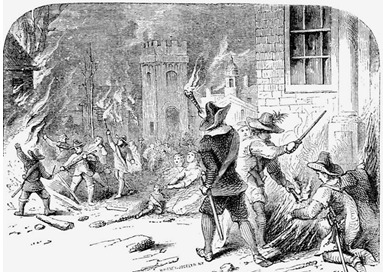
xxxxxBut the
settlement was not destined to survive. It was frequently attacked
by local Indians, and suffered particularly heavy loses in two
savage wars -
xxxxxToday, the
Fort James of 1607 has been recreated in the Jamestown Festival
Park, along with full-
xxxxxIncidentally, important though this English settlement proved to be in the history of the United States, it is worth remembering that North American Indians had occupied this area for some 3,000 years. Furthermore, it is more than likely that Norsemen led, by the intrepid Leif Eriksson, landed in the Cape Cod region around the year 1003.
J1-
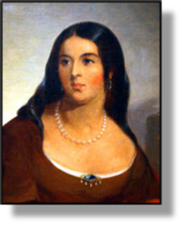 XxxxxSaving the life of the English adventurer John Smith,
captured by her tribe in December 1607, brought unexpected fame to
Pocahontas, the
thirteen-
XxxxxSaving the life of the English adventurer John Smith,
captured by her tribe in December 1607, brought unexpected fame to
Pocahontas, the
thirteen-
xxxxxHer father paid the ransom for her release, but by this time she had fallen in love with John Rolfe, a successful tobacco planter, and their marriage was sanctioned by both the Virginian governor and Chief Powhatan. This union brought eight years of peace between the English and their Indian neighbours. In 1616 she and her husband travelled to England, where she was received by the king and queen and admired wherever she went for her beauty and charm. Sadly, in March 1617, just before departing for Virginia, she died of smallpox and was buried in the chapel of the parish church of Gravesend. John Rolfe returned to Jamestown and, ironically, was killed in the war with the Powhatan Indians in 1622. Their only son, Thomas Rolfe, was educated in England and returned to America in 1640. A number of books have been written about Pocahontas, and a Walt Disney film has been made about her extraordinary life.
xxxxxSaving
the life of the English adventurer John Smith, captured by her
tribe in 1607, brought unexpected fame to the chief’s daughter,
thirteen-
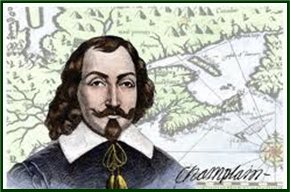 xxxxxIn 1608, a year after the establishment of Jamestown,
the French soldier and explorer Samuel de Champlain
(1567-
xxxxxIn 1608, a year after the establishment of Jamestown,
the French soldier and explorer Samuel de Champlain
(1567-
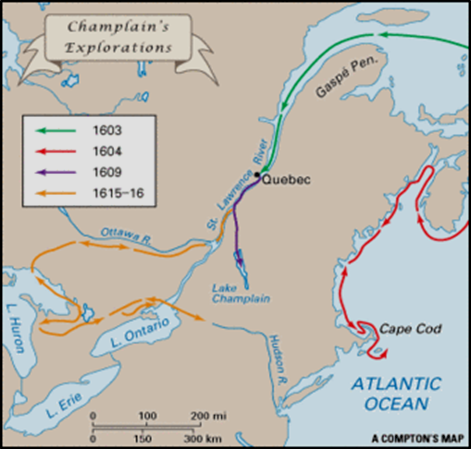
xxxxxChamplain was
born in Hiers Brouage, western France. He served in the army of
Henry IV and then in 1599 made a voyage to the West Indies and
Spanish America. Later, reporting his findings to his monarch, he
put forward the idea of a canal across the Isthmus of Panama as a
means of shortening the passage to the South Seas. (The canal was
eventually built 1904-
xxxxxIt was on his
third expedition to Canada, in 1609, that he reached Quebec and set up a fur trading
fort. He may well have given the settlement its name, derived from
an Indian word meaning "where the river narrows". It was from
here, realising the importance of Indian support, that he formed 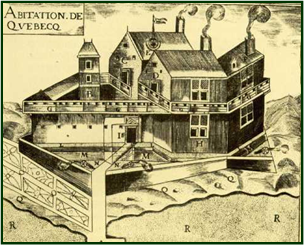 an alliance with the local tribes,
the Algonquin and Hurons, and actively supported them in their
conflict with the Iroquois to the south, using firearms for the
first time to ensure victory. It was while fighting in support of
the Canadian Indians that he discovered the lake that today bears
his name. Two years later, in 1611, he established a trading
station at Montreal, named by Cartier in 1535. Then,xhaving sailed up the Ottawa river as far as Allumette
Island, in 1615
he explored Lake Ontario, accompanied by his fellow countryman, Étienne Brûlé -
an alliance with the local tribes,
the Algonquin and Hurons, and actively supported them in their
conflict with the Iroquois to the south, using firearms for the
first time to ensure victory. It was while fighting in support of
the Canadian Indians that he discovered the lake that today bears
his name. Two years later, in 1611, he established a trading
station at Montreal, named by Cartier in 1535. Then,xhaving sailed up the Ottawa river as far as Allumette
Island, in 1615
he explored Lake Ontario, accompanied by his fellow countryman, Étienne Brûlé -
xxxxxIn 1629, when
an English force raided and captured the settlement of Quebec -
xxxxxSon of a naval captain, Champlain showed a remarkable ability both as a navigator and cartographer. His accounts and maps of the territory, many included in his Voyages in Western New France, greatly aided future settlement. When he died in Quebec in 1635 the colony was still in its infancy, but his exploration of eastern Canada, his development of the fur trade, and the alliance he had formed with the local Indian tribes, helped to pave the way for the making of a substantial French empire in North America.
xxxxxIn 1608, a
year after the establishment of Jamestown, the French explorer Samuel de Champlain (1567-


